|

|
Maritime Topics On Stamps : Sail Types - Sails
| |
Hanse cog with a square sail
|
|
This page doesn't show any types of sailing ships. Instead it tries to describe the
different types of sails from the beginning of shipping up to today.
|
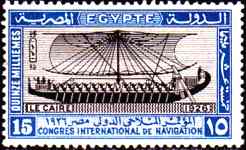
| 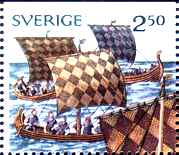 |
The oldest known sail is the square sail. It is fastened under a round spar which
is named a yard. The yard is horizontally attached to the mast by its middle.
In the relief to the left you can see an Egyptian sailing ship around 1500 B.C..
It was taken from the death temple of the queen Hadschesput. The square sail is fastened to two
yards. At the lower yard are ropes to bend it upwards. The reason was to
prevent dipping the yard-arms into the sea, when the boat was rolling. The sails
were made of linen and often beautifully coloured. The yard had a length of about
65 feet and the sail measured 1,170 square feet.
To the right a viking boat with a
square sail, about 800 A.C.. The earliest viking sails were made of wool,
but wool is very flexible and tearing easily. To prevent this, the
vikings sew a net onto the front part of the sail. The nets were made of ropes or
stripes of cloth. You can even see the ends of the net dangling beneath the sail.
Later on the viking boats had sails strengthened with leather ropes and sometimes
even sails made of linen.
|
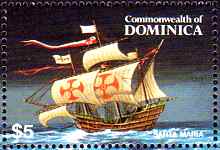
|

|
To the left you can see a galleon of the 16th century. Square sails are set on the jib-mast
and main-mast. In addition a square sail is set below the bowsprit, the so called 'blinde'.
On the mizzen-mast a lateen sail is set (see below).
To the right a clipper ship under full rig (all sails possible) from the 19th century.
These fast ships had square rigs on each of their three or four masts. A speciality of this
ship type were the 'lee-sails' attached to the outer ends of the yards (very good recognizable
on the stamp). On courses with aft winds they were set with extension spars fastened to
the normal yards. By this means total sail area was increased considerably.
The square sail has endured throughout the centuries, and even today it is in use on many
training sailing ships.
Its major strengths lies on courses with aft winds and during gales and rough sea. But, it
was impossible to sail so close-hauled to the wind as with other sail types. This was the
reason many sailing vessels used combinations of square sails and staysails for their rigs.
|
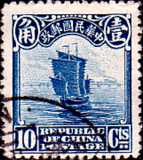
|
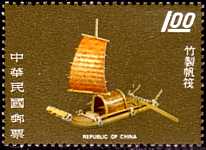
|
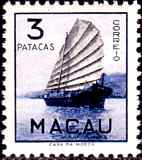
|
A lug sail is a square sail and fastened to a round spar, too. But this spar is
diagonally attached to the mast and shifted to one side of the ship. The sails of a junk
are typical lug sails as depicted on the stamps to the left and right. They are made of
plaited mats and stabilized with long bamboo battens.
On the stamp in the middle you can see the mats in the sail of the Sampan boat.
|
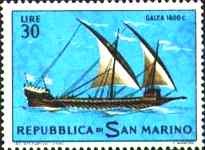
|
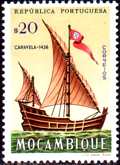
| |
A lateen sail is a triangular sail which is fastened to a very long, diagonal round spar.
Technical literature describe a diagonal yard which extended over the mast and bow. Sometimes
these spars were as long or longer than the ship. This type of sail spread all over the
Mediterranean Sea since the 10th century. It was used on galleys (stamp to the left)
and galeasses. Since the 15th and 16th century they could be found on caravels,
feluccas and different small vessels in this area,as well (stamp to the right).
The lateen sail had a big advantage over the square sail as it was possible to sail
more close-hauled to the wind.
|
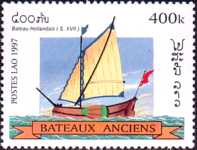
|
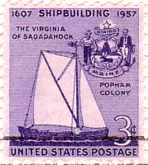
| |
The spritsail was sighted for the first time in the 16th century in the Netherlands. It was
impossible to sail through the narrow Dutch seaways with a great square rigger. This inspired
the development of the spritsail and the staysail. The spritsail was a simple
triangular sail, whose leading edge was fastened to the mast by a rope. It was tightened to the
aft with a diagonal spar. As we can see on the two stamps, this was used on many small
sailing boats.
|
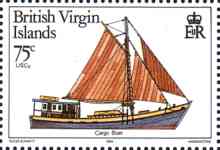
|
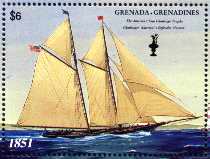
| |
A gaff is a wooden spar with a fork at one end. To this gaff a four-cornered
sail is fixed. The diagonal gaff props itself with the fork against the mast and partly
encloses him. This fork is called the throat of a gaff. Sails are hoisted using ropes,
which are called halliards.
The gaff sail is set with a peak halliard (the zigzag line between the gaff and
the mast on the left stamp) and a throat halliard. It is attached to the mast using
a simple rope or wooden rings.
The lower edge is fastend to a spar called boom. In the gap between gaff and
mast a gafftopsail could be set (as depicted on the stamp to the right). The schooner
on this stamp is the 'America', which won the first America's Cup in 1851
(have a look at
our page about the America's Cup).
|
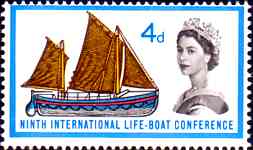
|
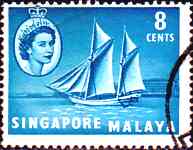
| |
In the middle of the 17th century the gaff sail was developed from the spritsail.
It was successfully employed on small sailing boats, cutters, schooners, sloops and on the
jigger mast of great sailing ships - the barques and barquentines. On the stamp to the
right you can see a gaff sail without a boom. This sailing ship type was built in Indonesia and called 'Pinisi'.
On the stamp to the left there is a lifeboat
equipped with a luggersail. The difference is the spar, to which the sail is fastened.
It passes the mast at the port side while the gaff props against the mast.
|
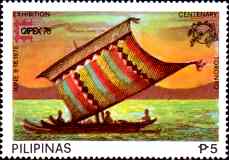
|
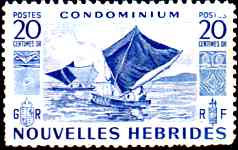
| |
The term trapezoid sail is only used in the technical literature dealing with the South-Sea.
A trapezoid sail is a square sail with two parallel edges of different length (as with the
Philippine boat depicted on the stamp to the left). Technically it is a luggersail, too.
The term trapezoid sail fits better with the adventurous construction on the stamp to
the right. Here the square sail is spread wide by two long spars. Like other asian sails these sails
were made of plaited mats.
|
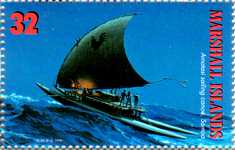
|
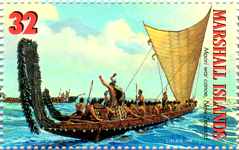
| |
Spreadsails are another speciality of the South-Sea. A large, triangular sail is spread by two
long spars. On the stamp to the left the spars have been bend to a curved form. To the
right the spars are form a straight 'V'. Another term for this type of sail is 'oceanic triangular sail'.
|
|
Among the sails of the Pacific there are a lot of similar types, but each one was
constructed and rigged differently. For example, we have this spreadsail which is called
'crab claw sail', because of its extreme form.
|
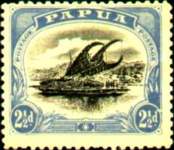
| |
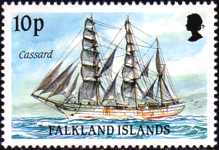
|
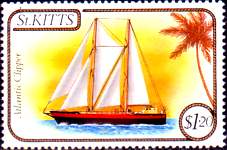
| |
The wires and ropes, which fasten the mast to fore and aft are called fore stays and standing
backstays. The wires and ropes, which fasten the mast to both sides are called shrouds.
Staysails are sails which will be set on the fore stays. You can find them in front of the mast or
between two masts (stamp to the left).
On the stamp to the right you can see two staysails before the mast and one staysail between the mast.
Directly above it is a three-cornered schooner sail. At the second mast aft there is a so-called
Bermuda sail. With staysails it is possible to sail close-hauled to the wind,
i.e. on a tack up to 30 degrees to the wind.
|
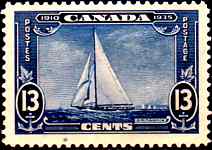
|
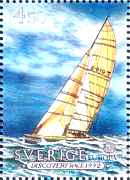
|
Today the Bermuda sail (or Marconi sail or jib-headed main sail) is the standard sail
on racer and touring yachts.
It is a triangular sail set behind the mast in the midshipline. With its leading edge,
the fore leech, it is fastened to the mast and the foot leech is fixed to a horizontal boom,
(stamp to the left).
------------------------
All sails aboard a ship have a name and the name says something about the place where the sail
was set. A Bermuda sail, set on the main-mast is called main sail, set at the jigger mast
is called jigger. The three staysails before the mast are calle inner jib, outer jib and
flying jib. An extremely large jib is called a genoa.
On a great fullrigger with jibmast, mainmast and mizzenmast the lowest square sail at the
jib mast has the name jib. On the stamp to the right there is a modern racing yacht depicted.
You can see the synthetic stripes which are used for modern sails today.
|
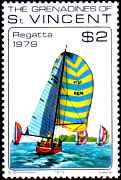
|
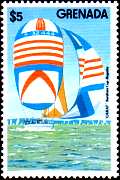
|
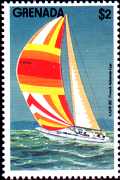
|
On touring yachts and racers are often special sails which look like balloons. They are set
to enlarge the sail area for aft winds. These sails are called spinnakers, or short 'Spis'.
On the windward side the sail is spread with a spinnaker boom to hold it broad, see stamp to
the left. To the right you can see a gennaker, a mixture of a spinnaker and a genoa. This
sail doesn't need a spinnaker boom. Other names for the gennaker include blister or flasher.
In the middle you can see a racer with a spinnaker and a blister.
On small yachts the spinnakers have a sail area of 500 to 720 square feet, on great racing yachts
up to 3,600 sqft. Most of them are made of light synthetic stripes. There are even special
spinnakers for calm winds which swell by the thermic of the sun and pull the ship forward.
|

|

|
Today professionals experiment with wing sails, e.g. the catamaran 'Stars and Stripes'
(stamp to the left). In 1988 the American Connor defended the America's Cup with this boat.
(Have a look at our page about the America's Cup).
The wing was seperated in fore, main and aft-wing. The main wing was split into six parts,
each one could be regulate seperately, see stamp. The material used for the construction was a special
carbon-fibre foam, covered with a polyester film.
In times of expensive fuel consumption people think about sail support for freighter and cruise liners.
And some ideas were realized (see stamp to the right). Revolving steel masts with folding
steel frames, between which large sails were set were built. On the stamp to the right the 'Shinaitoku Maru'
is depicted: a little coastal tanker, build in 1980 with 1,600 tdw. A three-year testing period
resulted in 15% less fuel consumption compared to a sister ship.
|
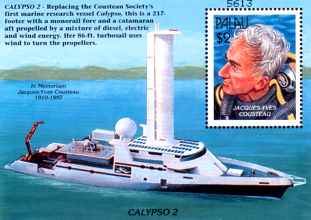
|
In 1924 the German scientist Flettner built a schooner named 'Buckau' with two rotating
cylinders, each 51 feet high. In 1985 the French sea-scientist Cousteau ordered a successor
ship for his 'Calypso', the 'Alcyone'. Now the 'Calypso 2' will follow. Both ships are
fitted with the so-called 'turbo sails'. Actually they are big wings and look very similar to
Flettner's rotating cylinders, altough they do not rotate. The 'Alcyone' has two turbo sails, each
23 feet high.
|
At the moment a team is collecting donations for the 'Calypso 2'. In the future this ship will
have a single turbo sail with a height of 85 feet.
Is this the future of sail development?
|
Some notices:
| |
The sail types shown are only the basic ones. There are many different versions and
variations regarding size, form, material used, thickness, etc. for each type.
And then sails are catgorized in light wind sails and gale sails as well. During a storm
or hurricane the crew set small sails made from heavy, solid material. During lesser winds light
and large sails are preferred.
| |
The first sails were made of reed, leaves, plaited mats or wool. There were even some prototypes
with wood. When people were able to produce cloth, sails were made of linen and later on of
cotton. Since the last 40 years plastics like Dacron, Mylar, Kevlar, Polyester, Nylon etc. were
introduced. Today experiments take place using aluminium foil and laminates consisting of different
synthetics on top of another ('sandwich style').
|
|